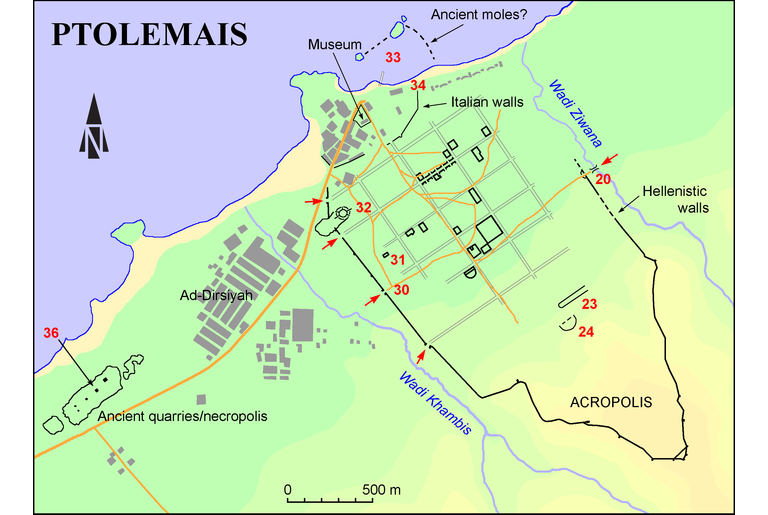Epitaph or honors for a gladiator
GVCyr018
Trismegistos ID: 738911
Source Description
Support
Limestone stele moulded above, the upper part of the face occupied by a round-headed niche with flanking columns in relief containing a relief of a gladiator (0.57-0.59; 1.74;0.28-0.30).
Layout
Inscribed in a tabula ansata below the relief (0.475; 0.21;); lines 2 and 3 encroaching on the right ansa, line 6 below the tabula.
Letters
0.03-0.035; lunate epsilon, sigma and omega.
Place of Origin
Findspot.
Date
Second or third century A.D. (lettering)
Findspot
Found before 1915 at Ptolemais pleiades; HGL : in the Amphitheatre (see commentary).
Later recorded Location
Seen at an unknown date by J.M. Reynolds at Ţulmaythah : in the Tolmeita Museum .
Last recorded Location
Seen by Dobias-Lalou in 1985 at the same place.
Text constituted from
Transcription from previous stone (CDL).
Bibliography
Oliverio, 1933-1936 Oliverio, G., 1933-1936, Documenti antichi dell'Africa Italiana, II, fasc. 1-2, Bergamo - see in bibliography , n. 493, p. 247, fig. 79, whence SEG Supplementum Epigraphicum Graecum, Leiden, then Amsterdam, 1923-1971, then 1979- - see in bibliography , 9.363. Cf. Robert, 1940 Robert, L., 1940, Les gladiateurs dans l'Orient grec, Limoges - see in bibliography , p. 124, n. 69; Peek, 1955 Peek, W., 1955, Griechische Vers-Inschriften, I-II, Berlin - see in bibliography , n. 835.
Text
| Τούτους μὲν κα|τέπεφνεν [Ἄ]ρης καὶ | φύλοπις αἰνή·
ἐμὲ δὲ | νῦν κατέπεφνε νό|(5)σος σωθέντα σει|δ̣ήρου.
Apparatus
1-2
Oliverio, 1933-1936
Oliverio, G., 1933-1936, Documenti antichi dell'Africa Italiana, II, fasc. 1-2, Bergamo - see in bibliography
κα|τέπεφνεν : SEG
Supplementum Epigraphicum Graecum, Leiden, then Amsterdam, 1923-1971, then 1979- - see in bibliography
, Robert, 1940
Robert, L., 1940, Les gladiateurs dans l'Orient grec, Limoges - see in bibliography
κα|τέπεφνε
4
SEG
Supplementum Epigraphicum Graecum, Leiden, then Amsterdam, 1923-1971, then 1979- - see in bibliography
, Robert, 1940
Robert, L., 1940, Les gladiateurs dans l'Orient grec, Limoges - see in bibliography
κατέπεφνε : Oliverio, 1933-1936
Oliverio, G., 1933-1936, Documenti antichi dell'Africa Italiana, II, fasc. 1-2, Bergamo - see in bibliography
κατέπεφνεν : Peek, 1955
Peek, W., 1955, Griechische Vers-Inschriften, I-II, Berlin - see in bibliography
κατέπεφνε{ν}
French translation
Ceux-là ont été tués par Arès et son atroce mêlée;
moi, c'est la maladie qui m'a tué quand j'avais réchappé au fer.
English translation
Those have been killed by Ares and his dread din of battle;
me, it was disease that killed me after having escaped iron blades.
Italian translation
Questi li ha uccisi Ares e la sua atroce pugna;
quanto a me, la malattia mi ha ucciso dopo che ero sfuggito al ferro.
Commentary
At Ptolemais, were found three other steles for gladiators (IRCyr P.220, IRCyr P.221 and GVCyr017); only the latter and this one were composed in verse and mention a reason for death. The findspot of GVCyr017 is unknown, whereas the three others were found together.
This inscription has been incorporated into the epitaphs (SEG, Peek). However, Oliverio, 1933-1936 Oliverio, G., 1933-1936, Documenti antichi dell'Africa Italiana, II, fasc. 1-2, Bergamo - see in bibliography reported that this one, IRCyr P.221 and GVCyr017 were found in the cavea of the amphitheatre. Kraeling, 1962 Kraeling, C.H., 1962, Inscriptions, in C.H. Kraeling et al. (eds.), Ptolemais: city of the Libyan Pentapolis, University of Chicago Oriental Institute publications90, Chicago, 208-215 - see in bibliography , p. 110 thus thought that «they were presumably not connected with funerary structures». Differently, Ghislanzoni-Oliverio, 1915 Ghislanzoni, E., (from Oliverio, G.), 1915, Notizie archeologiche sulla Cirenaica, Notiziario Archeologico del Ministero delle Colonie1, 65-239 - see in bibliography , pp. 122-124, who visited the place before Oliverio, had been told that the two others (the inscription of which gives no clue for or against a funerary function) were found in the West necropolis, re-used as lids of later tombs. As the amphitheatre and the West necropolis were situated not far from one another on either side of the city wall, stones might have been moved here and there. However, the use of τούτους as first word of this one shows that all three steles stood originally together. Either the spot was really the amphitheatre and the inscription is honorary in spite of the funerary topic, or gladiators were buried in a common area and we should thus consider the inscriptions as epitaphs.
At the beginning of line 2, the short syllable is metrically lenghtened; σειδήρου has a ει for a short iota because of iotacism. Both hexameters are quite regular.
Creative Commons Attributions-NonCommercial 4.0 International License.
All citation, reuse or distribution of this work must contain a link back to DOI: http://doi.org/10.6092/UNIBO/IGCYRGVCYR and the filename (IGCyr000000 or GVCyr000), as well as the year of consultation.
